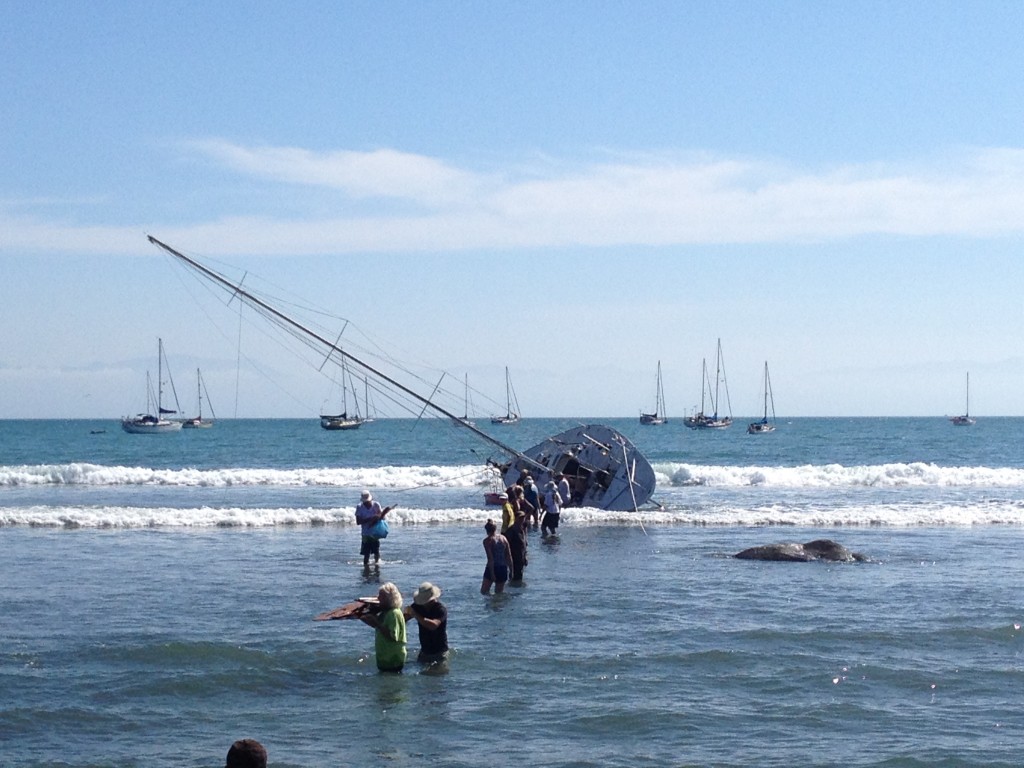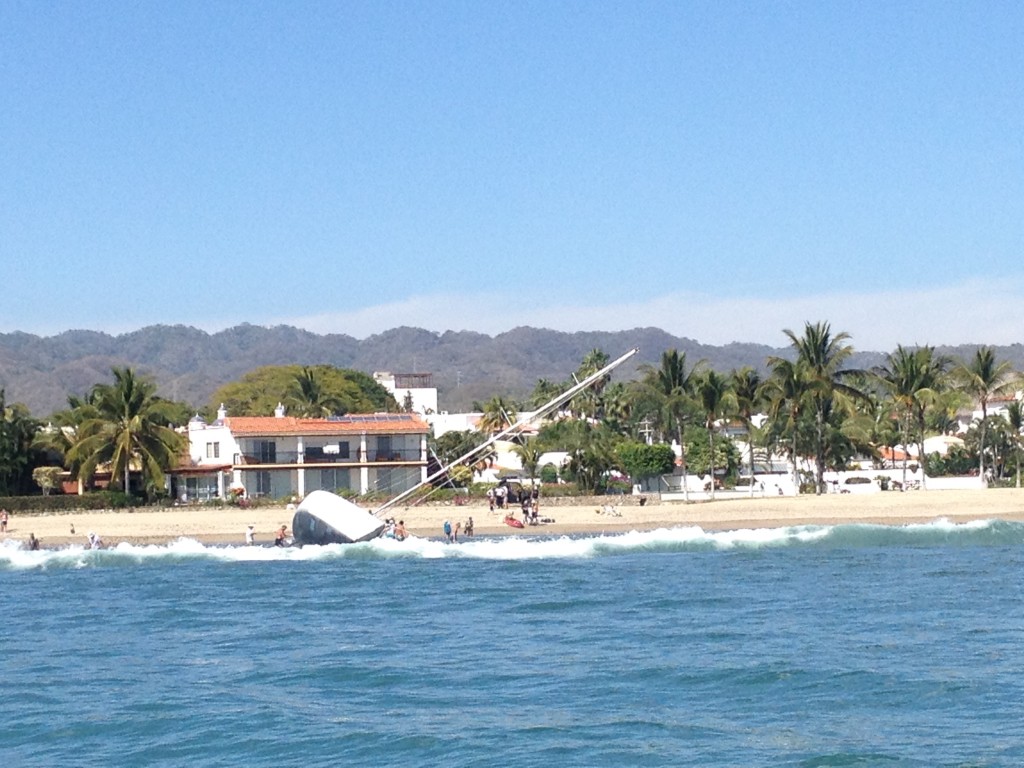
One thing about voyaging on boats that has always been interesting to me is the aspect of accountability. The sea can be a very demanding and challenging environment. While this can be equally true on land, most environments we live in are generally more forgiving that the sea. At sea each crew member needs to be fully responsible for their own duties, and their impact on the rest of the team. In particular, each captain is ultimately responsible for the safety of crew and vessel. To be honest, I was surprised at first by the extra weight of that role. I had made several coastal passages and sailed double-handed to Hawaii with my good friend and salty sea Captain Chuck Shuster, but the first time the family and I sailed our own vessel off the Washington coast I felt the full impact of responsibility that comes with being captain of the ship. In general, it’s one of the things about our journey that feels right to me.
This responsibility affects our kids as well, and I think it’s excellent training for life. As crew, they each have serious duties aboard the boat. In harbor this includes galley cleanup & dishes, helping to scrape barnacles off the hull, and cleaning & hoisting the dinghy at night. At sea the kids take watches so that Karen & I can get the rest necessary to keep the boat going through the night. When on watch, Sean and Sarah have to make serious judgements to keep the vessel, and all of us, safe while underway. It’s not just convenient, it’s necessary, and it’s how we function as a team. While sometimes goofy and occasionally downright silly, the kids seem to sense the seriousness of theses important moments and rise to them. In voyaging, there are plenty of real moments to rise to; it’s another empowering aspect of the voyaging life.
On the flip side, we are each human, and therefore prone to mistakes and mis-judgements. As a consequence, things can come crashing down in a big way when our responsibilities loose their footing on top of our humanity. This is where responsibility turns into accountability. We were reminded of this three days ago when a forty foot sailing vessel, Rage, went on the rocks here in La Cruz de Huanacaxtle. What follows is my account of that sad story.
I was surfing with a friend who noticed the boat dragging on her anchor. By the time I made it back aboard Batu, we watched in horror and disbelief as Rage’s keel made the first impacts with the jagged rocks just off the point we were surfing from. I made several radio attempts to hail the Captaina de Puerto, but weekends are not well staffed and the office can be busy. I made a “securite” call on the radio while blasting over in the dinghy to see what could be done. By this time Rage’s jib had come partially unfurled from the shuddering impacts of surf pounding her on the reef. She had been pushed into 4-5 feet of water, not a good thing for a 12,000 lb wood & fiberglass vessel with a 6.5 foot draft. Someone produced a 150 foot nylon anchor rode and I volunteered to swim it in to attach to the vessel. Having just surfed this point I was somewhat familiar with the shallow, jagged, urchin-covered rocks and felt I could accomplish the task safety even in the 4-6 foot swell. Although 150 feet sounds like a lot of line, it doesn’t look like much when connected to an 8 foot dinghy and strung through the surf zone. Just after connecting the long rode to the stranded boat’s anchor line I turned around to see a particularly large set of waves rolling in with the dinghy in a perilous position The image of that little dinghy clinging to the vertical green wave face as white spindrift broke over her bow is one I will not soon forget. One dinghy overturned, a second, nearly taken. In the end, all people and gear were wet, but intact. I swam the nylon line over to a Mexican fishing panga who began using maximum RPMs to pull the stranded vessel off the rocks. When another large set of waves came the captain wisely chose to abandon the line and save his panga. We hastily assembled an Uber-kedge anchor using a 75lb CQR, Batu’s heavy, 270 foot braided nylon rode and another 100 feet of similar 1 inch nylon. Again, I swam the line in and, as darkness set, we placed the kedge outside the surf line to control the vessel during the rising tide. By this time we understood that Rage had reached her final resting point. With two-thirds of her port side stove-in she would not float again. Since that time we’ve joined the efforts to control the environmental impacts by removing fuel, oil, batteries and debris as well as helping the owner salvage anything of value from the vessel.
So why did this happen? I have an opinion, but it doesn’t really matter. The only thing that matters is that it did happen. Each captain and crew should be curious to investigate the situation so they can make better-informed decisions about matters of their own critical responsibility. Here’s what I know; Rage was originally anchored in about 20 feet of water plus 4-5 foot height of bow. The seabed is rocky and the owner was staying ashore at a nearby villa. Rage was using a 35 lb compact fluke-type anchor made by FOB. Despite having several fathoms of chain in the anchor locker, the anchor rode itself had about 30 – 40 feet of chain. The rest of the rode was nylon rope. By my estimate the total rode length (including chain) was between 75 and 100 feet long. Therefore the total scope was 3:1 or maybe 4:1. She began dragging just after high-tide with a 4 – 6 foot swell lifting the hull. Until she hit the reef, nothing broke or parted.
Rage was a very special boat, hand-crafted by the owner using a technique known as cold-molding; she was made using layers of wood covered in fiberglass. Building a boat like this is a monumental task, and she was well-done. From what I understand, Rage took over six years to build, she raced in at least two TransPac races (California to Hawaii), and she was fast. It must be a devastating loss for the owner. Thankfully, no one was seriously injured in the wreck or salvage attempts. Although the vessel was insured, it is my understanding that the owner’s claim was denied due to items in the “fine print.” Fortunately, the cruising community rallied to help contain the environmental impacts and salvage everything possible from the vessel. I saw his face, so I know that Rage’s owner & captain feels the full weight of accountability on his shoulders, and I can empathize with that. There’s a bare honesty and integrity in his acceptance. Sometimes I think the world could use more people like this, people willing to be fully accountable for their actions. How would the financial crisis of 2008 have ended if certain bankers and mortgage brokers had been forced to accept this type of bare humility and accountability?
I suppose what’s interesting to me about this is that nature, in this case the sea, judges with true impartiality. In fact, she’s wholly indifferent. Although this view of nature is somewhat stark and certainly unforgiving, it is as pure and real as it gets.

Thanks. Hear you are about to puddle jump, can’t wait to see the photographs. We had a tour company in Alaska whose captains found land with the bottom of their boats so often that all the bars had a drink named after them. It could be anything, as long as it was on the rocks. Big hugs to the family.
Hi guys, just realized that I might be leaving comments on the wrong page. I think they are on the Admin About Us area??? Anyways, you can check there but I wanted to say
“HAPPY 14th BIRTHDAY SEAN!!” What a wonderful way to celebrate – on a boat in paradise! I love reading about all that you are doing and seeing. You look great, quite a glow about you! We love you! Cindy and Dean and Lauren